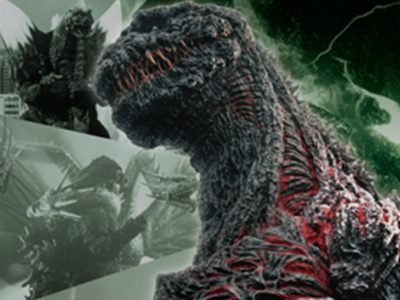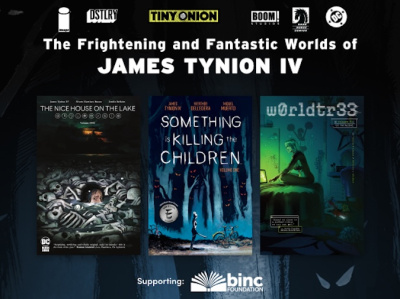 At New York Comic Con, ICv2 caught up with DC co-publishers Jim Lee and Dan Didio to discuss the market, including the changes to the audience for comics, DC’s recent licensing snafus, the upcoming move to the West Coast, the plan for Vertigo, and more.
At New York Comic Con, ICv2 caught up with DC co-publishers Jim Lee and Dan Didio to discuss the market, including the changes to the audience for comics, DC’s recent licensing snafus, the upcoming move to the West Coast, the plan for Vertigo, and more.What is your evaluation of the state of the market? What kind of year is DC having?
Lee: We’re having a very good year, much in line with how we did last year. In terms of a profile of the state of the union of comics books in general, I think it’s still a golden era of comics right now.
There are so many great things happening with superheroes and pop culture. The Flash did extremely well. It’s the highest rated pilot in five years for CW (see "'The Flash' Posts Best CW Debut in 5 Years"). Gotham is doing extremely well (see "Fox Opts for a Full Season of 'Gotham'"). The visibility of what we do is higher than ever.
Then you see what we did when we unveiled the Batman stamp. It just goes to show you that these are characters are ubiquitous throughout pop culture, and it’s really our mission to capitalize on that awareness and sell more comic books than ever before. So far we’ve been making some really good strides toward that. We started selling some books though Best Buy and we had some decent success with that. Digital is still going strong.
Can you tell us more about the Best Buy program?
Didio: It was this month and was part of a program we did in conjunction with Warner Home Entertainment. We’ve been packaging up our trade paperbacks that are associated with the DVDs, so you saw a package with the Godzilla DVD and Justice League: War. It was a three-book program and the numbers were so strong we’re going to continue the program.
Thanks, further thoughts on the state of the market?
Didio: You see the marketplace expanding, which is interesting to me.
The market in comic stores was flat in first half; that turned around in third quarter.
I see a bullish market in terms of the other companies. You see an expansion of lines and companies adding more and more product going on here.
You look at the comic stores themselves, and I don’t know if I could own one, to be honest with you, when you look at 400 periodical products coming out every month. How do you choose which are the ones that are going to go there and how do you manage that system, especially in a non-returnable business? Therefore it’s important for us to be as confident of the product as we can and make sure we put together the best product so it stands out on a very crowded shelf but also be able to move through, so all these stores can flourish along with us.
September was an extraordinary, wonderful month for us, because last year when we did the lenticular cover month we had a lot of success but also some concerns because we had to allocate books at the beginning. We sat down with the retailers on several occasions and came up with a system that we think benefited everyone. I think the strength of our September numbers really shows it was a really strong partnership between DC Comics and the retail stores to make sure there was proper inventory on the shelves to get out to the fans.
Lee: There’s also a diversification within the audience itself the past couple of years. You’ve seen more women, more female readers, in general. When we launched Batgirl and Gotham Academy, those books struck a different note, different tonality, and that was in large part due to editor Mark Doyle bringing these projects together with different kinds of creators (see "Two New Batman Ongoing Series" and "New Batgirl Costume"). It was our way of broadening the base of the Batman family of books but doing it in a different way to attract a different audience.
I think it speaks well to the future that we’re not just going to strike the same note looking for the same customer. As part of trying to find how to bring these people that know of our characters through all of this other media into our business, you have to almost tailor-make the comics to their liking. You can’t necessarily rely on the same continuity, the same core hardcore comics-driven material; you have to diversify, broaden your net and bring in different voices to the company. That’s been a big initiative of ours through the year and you’ll see a broadening of that going into 2015.
Speaking of the growing female audience and striking the right note, over the last couple of weeks, DC apologized for some of its licensed products (see "DC Apologizes for Sexist Superhero Shirts"). One of your licensees apologized for not including female characters in the Justice League in their product (see "Another DC Licensing Apology, for a Game"). Who approves DC licensed products with regard to those issues and are you happy with the way that’s going?
Didio: Actually, we are. We have a strong relationship with our consumer products division that runs those areas. You have to understand that they’re seeing tens of thousands of products that they’re proof-reading and checking for information over a period of time. We have departments that work very closely with them within DC Entertainment, and they’re constantly working the system to make sure they’re aware of our audience and presenting the proper material to that audience.
Why didn’t it work in those instances?
Didio: It’s easy to point to the mistakes, but when you look at the aggregate amount of material that goes out on a regular basis you can see that it’s a very successful program and it’s managed correctly.
How’s the move shaping up (see "DC Comics Leaving New York")? How are you planning to deal with any disruption that might occur?
Didio: We’ve gone to great lengths to make sure there is no disruption. From my standpoint, from the consumer standpoint also, they should not see any disruption in our service. Whether the company is operating on the East coast, West coast, a combination, or any place in between, our real issue is to make sure we put out the books and get them to the fans and that they’re enjoying the material that we create.
We work with people all around the world all the time so our location, while we centralize in Burbank, should not affect our talent and hopefully should not affect our relationship with our fans.
Do you have any feel for the percentage of employees that are going to move?
Didio: Oh, I have actual numbers, I have more than a feel (laughs). I’m intimately involved with every beat and every step of the way.
Are you happy with the plans?
Didio: You have to have a certain attitude about looking forward and the challenges it’s going to bring. There is a certain melancholy that comes on because some of the people that you’ve worked with for an extraordinarily long period of time, extraordinary contributors, won’t be there. Like any company, like any business, even our characters, we have to bring change to it, and we have to make the change good and exciting for all of us. We have to grow and be as competitive as we’ve always been.
Over the last five or 10 years, Vertigo has gotten smaller in terms of its creator-driven projects. Image Comics, at that same time, has been expanding. Is it a conscious strategy to reduce your emphasis on those types of products? If not, what’s your strategy to counter it?
Lee: We’ve actually increased the number of periodicals, but we’ve probably reduced the total amount of Vertigo product in that we pulled back on the OGNs and other book format projects. It is a huge priority for us; it is something the company believes in very strongly.
If you look at what we’re going to do in 2015 (which I’m not at liberty to discuss at this moment), possibly first quarter next year, you’ll see that we’re going through a major effort to rebrand the imprint. That’s going to come about through the projects themselves.
We’re working on a hit list of the top creators in the business and we have some exciting news to unveil in the early part of 2015.
You just can’t rest on your laurels, especially on a creator-driven business. You don’t have the legacy of characters like Batman and Superman to draw upon. It really all comes down to the creators and the concepts that they bring to the table.
We work very closely with Geoff Johns and his group to maximize the impact of these projects, not just through publishing, but beyond through the Warner Bros. family. That’s been a part of our strategy. Stay tuned to 2015; there’s a lot of amazing things in the works.
In June you announced a new compensation plan for your creators (see "DC Changing Talent Pay"). Have you been happy with the effects of that on your ability to attract and retain talent?
Didio: Yes. We took great lengths to explain the plan to the talent and I think it was very well received. The reason we made the change is to be competitive with the other publishers in the sense that we’re working from a system that allows us more flexibility in regards to pricing and strategies. We’re going to be moving into different markets and also different formats.
When we created the original royalty plan it was based on a periodical model. We’ve grown from periodicals to graphic novels and adding a digital component, and now we’re working with different types of products combined with books, so we need a level of flexibility and this allows it. I think what’s important is the talent themselves can feel that they’re truly participating and receiving the benefit of the success of the property.
The response from the creators was positive?
Didio: Oh, yes. We’ve had a strong response and it was positive all the way through.







